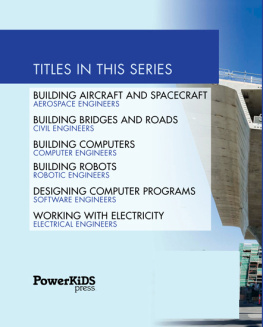Page List

Published in 2016 by The Rosen Publishing Group, Inc.
29 East 21st Street, New York, NY 10010
Copyright 2016 by The Rosen Publishing Group, Inc.
All rights reserved. No part of this book may be reproduced in any form without permission in writing from the publisher, except by a reviewer.
First Edition
Editor: Caitlin McAneney
Book Design: Katelyn Heinle/Tanya Dellaccio
Photo Credits: Cover ImagesBazaar/Getty Images; cover (background) Lev Kropotov/Shutterstock. com; cover, pp. 430 (gear vectors) Hunor Olah/Shutterstock.com; p. 5 (pyramids) Dan Breckwoldt/Shutterstock.com; p. 5 (Great Wall of China) Hung Chung Chih/Shutterstock.com; p. 6 iofoto/Shutterstock.com; p. 7 Kunal Mehta/Shutterstock.com; p. 8 Andrey Bayda/Shutterstock.com; p. 9 hxydl/Shutterstock.com; pp. 11 (drawing), 30 Fernando Blanco Calzada/Shutterstock.com; p. 11 (Brooklyn Bridge) kan_khampanya/Shutterstock.com; p. 13 microvector/Shutterstock.com; p. 14 https://commons.wikimedia.org/wiki/File:Joseph_Strauss_Memorial.jpg; p. 15 Martin M303/Shutterstock.com; p. 17 (New York City) Songquan Deng/Shutterstock.com; p.17 (architects) Dragon Images/Shutterstock.com; p. 19 Robert Cernohlavek/Shutterstock.com; p. 21 turtix/Shutterstock.com; p. 23 William Perugini/Shutterstock.com; p. 25 (glowing lines) Remko De Waal/Stringer/Getty Images; p. 25 (wind turbines) Moschen/Shutterstock.com; p. 27 (top) wavebreakmedia/Shutterstock.com; p. 27 (bottom) Hero Images/ Getty Images; p. 29 Goodluz/Shutterstock.com.
Library of Congress Cataloging-in-Publication Data
Hayes, Amy, author.
Building bridges and roads : civil engineers / Amy Hayes.
pages cm. (Engineers rule!)
Includes index.
ISBN 978-1-5081-4532-5 (pbk.)
ISBN 978-1-5081-4533-2 (6 pack)
ISBN 978-1-5081-4534-9 (library binding)
1. Civil engineeringJuvenile literature. 2. BridgesDesign and constructionJuvenile literature. 3. SkyscrapersDesign and constructionJuvenile literature. I. Title. II. Series: Engineers rule!
TA149 .H3285
624dc23
2015036124
Manufactured in the United States of America
CPSIA Compliance Information: Batch #BW16PK: For Further Information contact Rosen Publishing, New York, New York at 1-800-237-9932
CONTENTS
Have you ever wondered what keeps a bridge from falling down or makes a tunnels ceiling stay up? Have you thought about the pipes that run under cities and towns or how buildings can stretch high into the sky? Have you ever seen a whole river or lake being held back by a dam and wondered how it was built? The engineers who work on the roads, buildings, and foundations we depend on are called civil engineers.
Go on a walk and look at all the amazing structures under your feet and over your head. Whether its a house or a skyscraper, a highway or a small bridge on a country road, you can bet a civil engineer helped build it.
Civil engineering is one of the oldest forms of engineering. It began with ancient civilizations. The pyramids in Egypt and the Great Wall of China have something in common with todays roads and skyscrapersthey were designed by a talented group of engineers!


There are several different types of civil engineers. A transportation engineer is a person who specializes in making sure people can travel in the safest, most efficient ways possible. This means they design all sorts of roads and paths, from highways to railroads.
Transportation engineers make sure roads are built according to safety guidelines. To do this, they use a lot of math and a branch of science called physics. This allows them to predict how fast the cars can safely go depending on how abruptly the road turns. They also decide how many lanes there should be. They can even determine how traffic jams will start and come up with ways to prevent them.


Railroads have to be designed by engineers, too. Its very important to make sure trains stay on the tracks.
Roads have been around a lot longer than engineers. So when did people decide it was a good idea to get civil engineers involved? Once cars became popular, roads became much more dangerous. People on horseback traveled at much slower speeds than people driving cars. Cars presented new problems that needed solutions.
In 1921, the state of Ohio created the first state Traffic Engineering Bureau in the country. They hired Harry E. Neal to help organize and number the highways in the state. Soon, Neal developed a plan to draw lines on the road to prevent cars from crashing into each other. The idea of hiring people to create rules for the road with signs, lines, and speed limits spread across the country.


Cars were the reason that civil engineers got involved with creating roads. Now every road has to be carefully planned to make sure its safe.
Structural engineers work on all kinds of large projects, including buildings and dams. One of their specialties is creating bridges. Roads can get you quite far, but what if you have to cross a river or a lake? Structural engineers work with architects and construction workers to make sure any bridge thats built can withstand great amounts of weight.
Structural engineers have to know a lot about materialshow strong they are and how they react under different conditions. Structural engineers have a good understanding of physics and chemistry, two branches of science. They also have to use math every day as they perform important calculations that deal with the size of their structure and how the weight of its users and the pull of gravity will affect it.
Structural engineers think about what kind of bridge design would be safest. They have to think about how many people will be crossing the bridge and how long it will be.

Four major kinds of bridges are beam, truss, arch, and suspension. A beam bridge has a long, flat beam that vehicles drive over from end to end. Its supported by the two ends and sometimes poles underneath. A truss bridge usually has a series of steel bars assembled into triangle units.
The arch bridge has a big curve underneath its flat surface. The arch rises up towards the center and slopes down to either side. These lower ends hold the weight of the bridge. The last kind of bridge is a suspension bridge. It has tall towers with wires that come down and hold the bridge deck in place. Each bridge has different advantages and disadvantages. Structural engineers always work hard to figure out what kind of bridge they need to build.




















